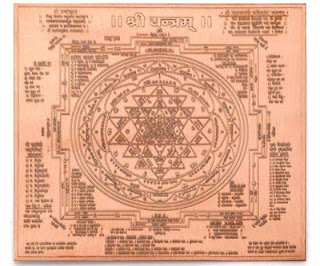The Shree Yantra
The Shree Yantra , called the “queen of yantras,” (rajayantra) is the symbol of the great divine mother principle, the source of all energy, power, and creativity. Vedic traditions, specifically the Shri Vidya school of tantra, regard the design as the representation of the universe as well as the body of the goddess related to the feminine principle of shakti or energy. Every line, triangle, and lotus petal symbolizes a specific type of shakti.
Next are three circles representing the past, present, and future. Within is the first ring of sixteen lotus petals representing complete fulfillment of all hopes and desires. Specifically, the petals represent the ten organs of perception and action (tongue, nose, mouth, skin, eyes, ears, feet, hands, arms, and the reproductive organs), and the five elements: earth, water, fire, air, and space. The sixteenth petal represents the mind, which gathers and interprets information from the perceptions of the interactivity of the elements.
Next is an eight-petal lotus. Each petal governs a specific activity: speech, grasping, motion, excretion, enjoyment, revulsion, attraction, and equanimity. Within the inner lotus is the first set of interlocked triangles. Those that point upward represent the masculine principle, downward represent the feminine. These triangles also represent qualities and Shaktis.
Starting at the lowermost outer triangle and moving in a counterclockwise circle, they are agitation, pursuit, attraction, delight, delusion, immobility, release, control, pleasure, intoxication, an accomplishment of desire, luxury, mantra, and the destruction of duality.
The next circle has the same sequence and direction, starting from the lowest triangle and moving counterclockwise. The first triangle is the giver of all accomplishments. Next is the giver of wealth. The third is the energy of activities that please all. Fourth is the bringer of all blessings. The fifth is the granter of all desires. Next is the remover of all suffering. The seventh is considered the appeaser of death. Eighth is the overcomer of all obstacles. Ninth is the bringer of beauty, and the tenth is the giver of all good fortune.
The ten smaller triangles in the third circle represent, beginning at the same, lowermost triangle and moving counterclockwise: omniscience, omnipotence, sovereignty, knowledge, destruction of all disease, unconditional support, vanquishment of all evils, protection, and the attainment of all desires. The fourth circle of triangles, again starting at the same point and moving counterclockwise, represent: sustaining, creating, dissolution, pleasure, pain, cold, heat, and the ability to choose action.
In the final inner space, the yogi or yogini visualizes five arrows representing the world of the senses, a bow, representing the mind, a noose, representing attachment, and a stick, representing aversion. The central triangle is the giver of all perfection. In the middle of the central triangle is a Bindu, representing pure consciousness and the original state of being.
Drawing the Shree Yantra Original -
Shri Yantra geometry is trickier than it looks — for centuries, mathematicians were required to create accurate Shri Yantras, free of mistakes. It was assumed that no matter how carefully it was created, there would be tiny inaccuracies that could not be seen with the naked eye. Bear in mind — the thicker the lines and the cruder the rendering of a Shri Yantra, the higher the odds that it is an inaccurate depiction.
How to Use the Shri Yantra
If you are using a Shri Yantra in a home or office, the Vedics recommend that it faces East. They also suggest occasionally bathing the yantra, if it is a copper and gold plate, in milk or rose water. If you want to go all out, place dots of sandalwood paste on the four corners of the yantra. Keep your yantra from accumulating dust or dirt. If the metal changes color from the milk/rosewater bath, it’s ok, the yantra is fine.
Shri Yantra Gazing Meditation
There are any number of Shri Yantras meditations, but one very direct way to bring the geometry into one’s consciousness is with a gazing method. This technique is used with many sacred symbols.
You’ll need:
- A blank, white wall, board, or piece of paper.
- An accurate Shri Yantra
- All three points of the largest triangles should be touching the outer circle.
- The uppermost point of each triangle should touch the horizontal baseline of the next or lower triangle.
- A timer
Sit comfortably in a position that allows you to remain alert. Have your Shri Yantra on hand as well as your blank white surface. If using a white wall, be sure you have a clear view.
Set the timer for five minutes and begin gazing at the yantra image. Keep the gaze soft — let the eyes relax and passively allow the image to enter the visual awareness.
Stay focused on the image. If the mind wanders, bring it back without judgment or reactivity.
When five minutes are over, immediately move the gaze to the blank white surface. Keep gazing at the afterimage as long as you can see it. When it fades, close your eyes, and allow any remaining afterimage to emerge. Keep your attention on it until it completely fades.
Repeat as many times as you like. Try doing the practice for 30-days and find out what happens to life under the influence of the Shri Yantra.

Comments
Post a Comment